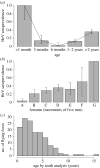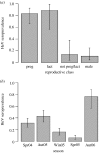Reproduction and nutritional stress are risk factors for Hendra virus infection in little red flying foxes (Pteropus scapulatus)
- PMID: 18198149
- PMCID: PMC2596896
- DOI: 10.1098/rspb.2007.1260
Reproduction and nutritional stress are risk factors for Hendra virus infection in little red flying foxes (Pteropus scapulatus)
Abstract
Hendra virus (HeV) is a lethal paramyxovirus which emerged in humans in 1994. Poor understanding of HeV dynamics in Pteropus spp. (flying fox or fruit bat) reservoir hosts has limited our ability to determine factors driving its emergence. We initiated a longitudinal field study of HeV in little red flying foxes (LRFF; Pteropus scapulatus) and examined individual and population risk factors for infection, to determine probable modes of intraspecific transmission. We also investigated whether seasonal changes in host behaviour, physiology and demography affect host-pathogen dynamics. Data showed that pregnant and lactating females had significantly higher risk of infection, which may explain previously observed temporal associations between HeV outbreaks and flying fox birthing periods. Age-specific seroprevalence curves generated from field data imply that HeV is transmitted horizontally via faeces, urine or saliva. Rapidly declining seroprevalence between two field seasons suggests that immunity wanes faster in LRFF than in other flying fox species, and highlights the potentially critical role of this species in interspecific viral persistence. The highest seroprevalence was observed when animals showed evidence of nutritional stress, suggesting that environmental processes that alter flying fox food sources, such as habitat loss and climate change, may increase HeV infection and transmission. These insights into the ecology of HeV in flying fox populations suggest causal links between anthropogenic environmental change and HeV emergence.
Figures





References
-
- Alexander J, Stimson W.H. Sex-hormones and the course of parasitic infection. Parasitol. Today. 1988;4:189–193. doi:10.1016/0169-4758(88)90077-4 - DOI
-
- Bastian S.T, Jr, Tanaka K, Anunciado R.V.P, Natural N.G, Sumalde A.C, Namikawa T. Evolutionary relationships of flying foxes (Genus Pteropus) in The Philippines inferred from DNA sequences of cytochrome b gene. Biochem. Genet. 2002;40:101–116. doi:10.1023/A:1015161305843 - DOI - PubMed
-
- Birt, P. 2004 Mutualistic interactions between the nectar-feeding little red flying fox Pteropus scapulatus (Chiroptera: Pteropodidae) and flowering eucalypts (Myrtaceae): habitat utilisation and pollination. PhD thesis, University of Queensland, Brisbane, Australia.
-
- Bossart K.N, McEachern J.A, Hickey A.C, Choudhry V, Dimitrov D.S, Eaton B.T, Wang L.F. Neutralization assays for differential henipavirus serology using Bio-Plex protein array systems. J. Virol. Methods. 2007;142:29–40. doi:10.1016/j.jviromet.2007.01.003 - DOI - PubMed
-
- Cattadori I.M, Boag B, Bjornstad O.N, Cornell S.J, Hudson P.J. Peak shift and epidemiology in a seasonal host-nematode system. Proc. R. Soc. B. 2005;272:1163–1169. doi:10.1098/rspb.2004.3050 - DOI - PMC - PubMed
Publication types
MeSH terms
Substances
Grants and funding
LinkOut - more resources
Full Text Sources
Miscellaneous
